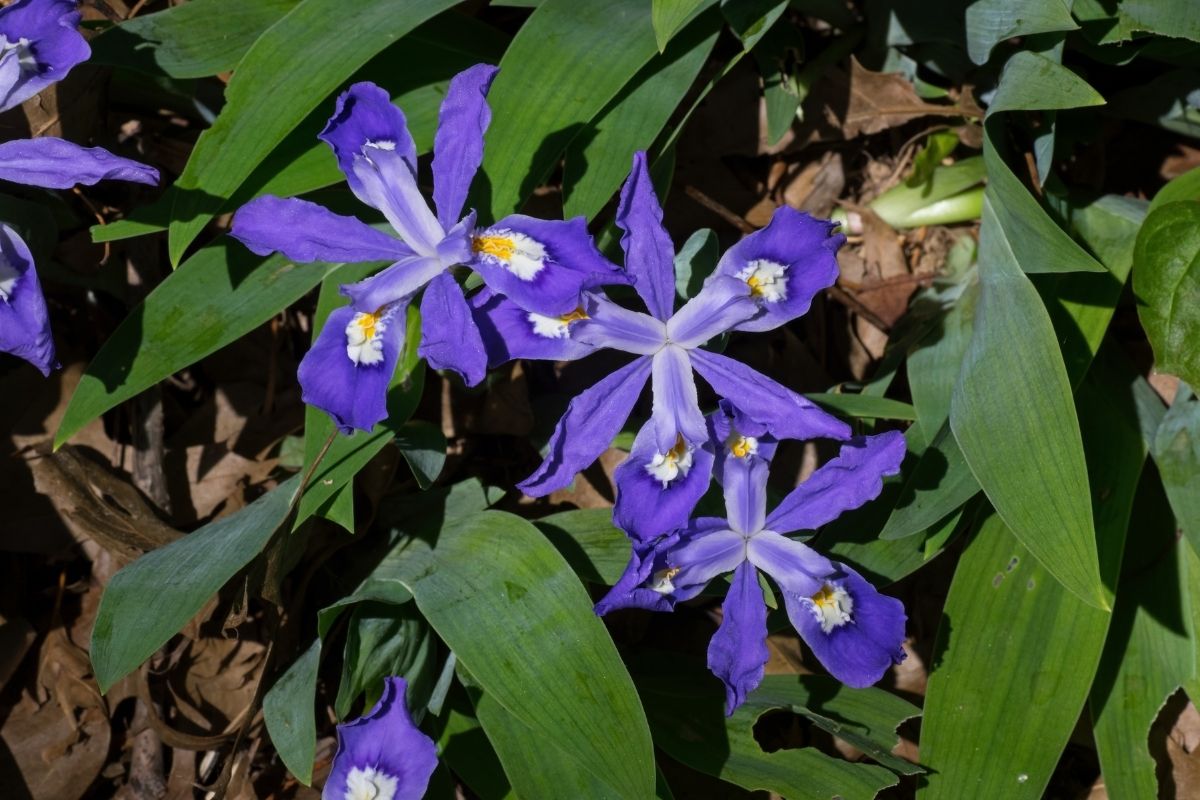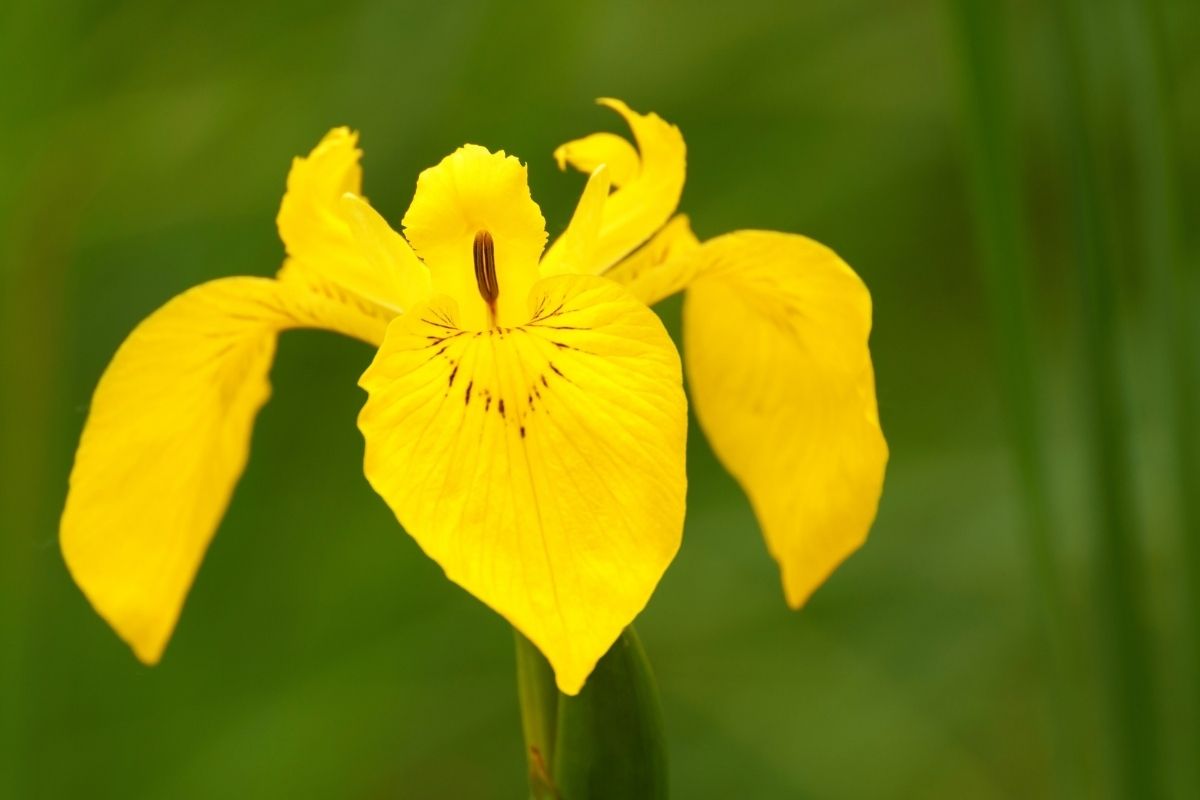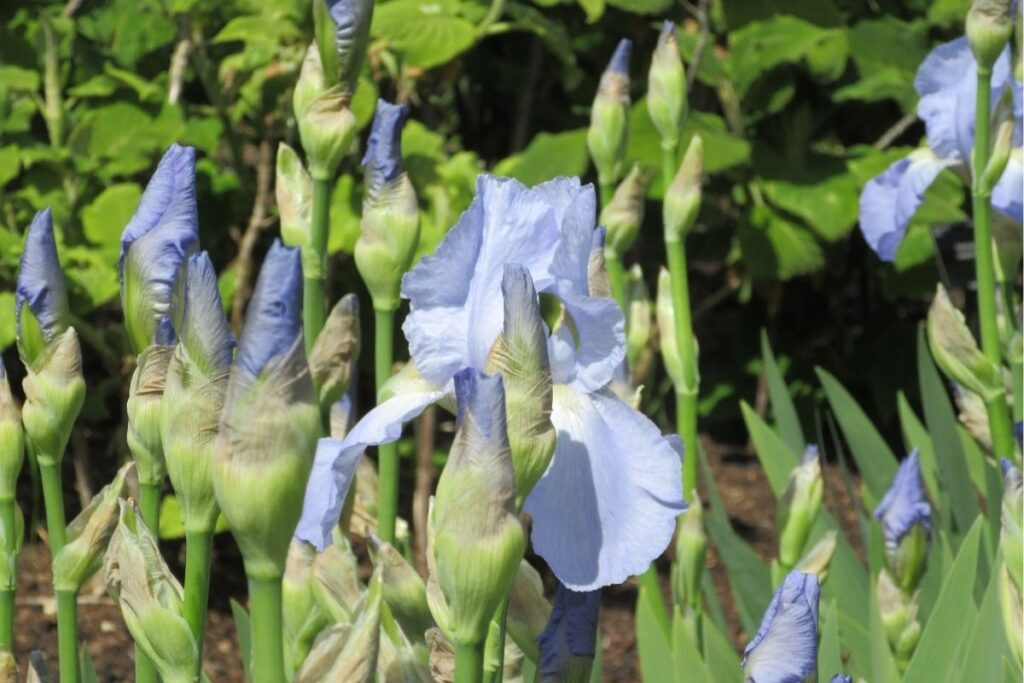There are up to 300 recorded species in the genus iris. Its name comes from the Greek word for rainbow, which some claim refers to the wide variety of flower colors found among the species of iris flowers.
If you’re curious to learn more about the various types of iris flowers, look no further.

In this article, I will cover many species of iris flowers, giving you an in-depth look into the vast variety of these fascinating Iris flowers.
Keep reading to find out more.
Bearded Iris
The bearded iris is an iconic and highly recognized plant that is native to southern Europe and the Mediterranean.

The bearded iris is categorized into several subdivisions, including the tall bearded (higher than 27.5 inches) and intermediate bearded (16–27 inches).
The bearded iris gets its name from the fuzzy beard that makes it look as if it’s sticking its tongue out. Bearded Irises are hardy and resistant to many common garden pests.
Dwarf Bearded Iris
The dwarf bearded iris is native to southern Europe and the Mediterranean, but is also naturalized in many other parts of the world.

Dwarf bearded irises produce similar blooms to that of the more famous tall bearded iris, but are a significantly smaller plant that blooms much earlier.
They grow from 8–15 inches high, and the subdivision miniature dwarfs are less than 8 inches high.
Dwarf Crested Iris
The dwarf crested iris flowers is native to eastern United States. These flowers grow to 6-inches high and tend to bloom from March to May.

Dwarf crested irises will attract hummingbirds and bees to your backyard, meaning they are great for promoting pollination of other flowers in your flower bed and can do a world of good for your backyard in general.
Siberian Iris
Iris sibirica, also known as the Siberian iris is native to temperate areas between Europe and Central Asia.

The Siberian iris is a subgroup in the American Iris Society’s beardless division, meaning that it doesn’t have the fuzzy “beard” that you’d expect from a bearded iris.
Unlike the bearded iris, whose foliage deteriorates after blooming, Siberian irises maintain their elegant foliage throughout the season.
Japanese Iris
The Japanese iris is native to eastern Asia and Kazakhstan. Japanese irises aren’t as renowned as the bearded iris, but their beauty will make you wonder why you haven’t looked into them before.

Japanese irises can grow from 2 to 4 feet high. That being said, Japanese irises require more care and attention than other varieties in that they require constant moisture, full sunlight and rich soil in order to thrive.
Dutch Iris
Dutch irises, also known as iris hollandica, is a hybrid iris that has been developed over the years from species of iris that are native to Spain, North Africa, as well as Portugal.

Dutch irises grow from 18 to 24 inches in height, and the color of their blooms range from white, pale blue, light yellow, through to dark blue and deep purple.
When planting dutch irises, you should plant them at the same time as tulips and daffodils.
Louisiana Iris
The Louisiana iris refers to a number of beardless hybrids derived from five species that are native to Louisiana and a few surrounding regions.

These five species include: Iris fulva, iris brevicaulis, iris hexagona, iris nelsonii, and iris giganticaerulea.
Louisiana irises can grow from 12 to 60 inches high, though the precise height tends to vary by hybrid. Similar to Japanese irises, these plants thrive from being in water, and a lot of these hybrids naturally occur in their native boggy habitats.
Yellow Iris
The yellow iris, also known as the yellow flag iris is native to Europe, western Asia, and northwest Africa. The yellow flowers typically appear between May and August, and yellow irises can grow from 15 to 39 inches high.

Yellow irises absolutely love water, and therefore can be found along the sides of ponds as well as in wet woodlands.
Blue Flag
Iris versicolor, also commonly known as the blue flag, is a species of iris that is native to North America, eastern United States, and eastern Canada.

Flowers are usually light to deep blue (purple and violet are not uncommon) and bloom during May to July. It is common to find blue flag irises in sedge meadows, marshes, and along stream banks and shores.
Wall Iris
Iris tectorum, also known as wall iris, is a species of iris that is native to Korea, China, and Burma. Typically speaking, wall irises grow to 15 inches in height.

Wall irises come in a variety of colors, including purple-blue, blue-lilac, lavender-blue, and sky blue, as well as white flowers.
Douglas Iris
Douglas irises are a species of iris of the coastal regions of Northern and Central California and southern Oregon in America.

The flowers blossom from April to June and are usually purple-blue in color, though white and yellow flowers have been found in the past.
Douglas irises are most commonly found in grasslands near the coast, and are much more drought tolerant when they are by the coast as they hugely benefit from cooler temperatures and fog.
Netted Iris
Netted irises is a type of iris that is native to the Caucasus, Russia, and northern Iran. This type of iris is fairly petite, typically growing from 4 to 6 inches tall.

Netted irises tend to blossom in early spring, and their flowers can range from yellow, blue, or purple with an orange tint. The bulbs need a consistent supply of water during the spring, but need to remain fairly dry during summer and autumn.
Cemetery Iris
Iris albicans, often referred to as the cemetery iris, is a type of iris that grows throughout the Middle East and northern Africa.

Cemetry iries get their name from the fact that they are often planted on the graves in Muslim regions to commomerate the lives lost.
The flowers are grey or silvery in bud, and are white or off-white in bloom. They typically grow from 19 to 39 inches in height.
Sweet Iris
Iris pallida, commonly referred to as sweet iris, is a type of iris that is native to the Dalmatian coast. These irises tend to grow from 16 to 20 inches in height, and are often cultivated to be garden plants.

Bearded irises produce flowers whose colors range from pale purple to white. Sweet irises bloom in May and June.
Crested Iris
The crested iris is a type of iris that is native to temperate regions of the United States of America.

The crested iris is fairly petite, and has an overall height with stem and flower reaching 3 to 4 inches tall. This species of iris has pale lavender flowers with a white patch and orange or yellow crest.
Iris Lactea
Iris lactea is a species of iris that is native to temperate and tropical regions of Asia. This iris is highly resistant and adaptable to drought and drier conditions.

In the United States, this iris is known as the ‘milky iris’ and in the UK is more commonly known as the ‘white flowered iris’.
The flowers produced by this species of iris come in several different shades – from violet, to pale blue, white, as well as yellow, and tend to bloom between April and June, or May and August depending on the location. They are between 5 to 27 inches in height.
Iris Aphylla
Iris aphylla, also known as leafless iris, is a species of iris that is native to central and eastern Europe, as well as temperate Asia.

This species of iris is highly variable in the wild, especially when it comes to its height and color. The color of the blooms can range from shades of bright purple, purple and violet to dark blue, blue-violet and dark violet.
The flowers will typically bloom between spring and early summer, but they occasionally have a secondary bloom in the autumn between August and September or September and October.
Iris Japonica
Iris japonica, commonly known as ‘butterfly flower’, is a hardy species of iris that is native to China and Japan.

This iris tends to flower between May and June, with blooms that range from shades of pale blue, pale lavender, lilac, purple, and white. Although it can be found in areas of woodland across Japan, where it grows usually indicates where an area was once inhabited and later abandoned by humans.
This species of iris is cultivated as an ornamental plant in temperate regions. It is commonly cultivated in the United States of America, and is the most commonly cultivated crested iris in the United Kingdom.
In Summary
So, there you have a variety of different irises! Although this article has covered a wide variety of irises, there are up to 300 species for you to discover and read up on.
That being said, I hope this article has given you a better idea of the different types of irises, and has piqued your interest in finding out more about them.
Before you consider planting irises in your backyard, make sure that you research the species that you’re interested in and know its needs beforehand.







